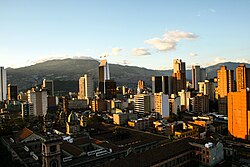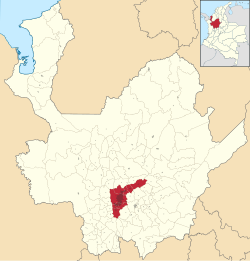The Metropolitan Area of the Aburrá Valley
The Metropolitan Area of the Aburrá Valley (Spanish: Área Metropolitana del Valle de Aburrá) is the second most important and populated metropolitan area in Colombia. The region is made up of ten municipalities, Medellín being the most important, largest and the capital city of the Antioquia Department.
The Metropolitan Area of the Aburrá Valley
Área Metropolitana del Valle de Aburrá | |
|---|---|
 Medellin | |
 Location of the Aburrá Valley region within the Antioquia Department | |
| Country | |
| Area | |
| • Metro | 1,157 km2 (447 sq mi) |
| Population | |
| • Metro | 4,055,296 |
| • Metro density | 3,500/km2 (9,100/sq mi) |
| GDP[1] | |
| • Metro | US$ 35 billion (2023) |
| • Per capita | US$ 8,500 (2023) |
History
editThe Metropolitan Area of the Aburrá Valley was the first metropolitan area created in Colombia, in 1980. The metropolitan area was created in order to produce economic integration, projection, and planning for urban development in the cities over the Aburra Valley.
The total population of the ten cities and municipalities part of this metropolitan area is close to four million inhabitants. The development of the Aburra Valley occurred in the 1930s after a rapid population growth that produced a conurbation of Medellín, Itagüí, Envigado, and Bello.
Medellín, as the capital of the Antioquia Department, main economic center and host of most of local government entities contributed to a rapid urban development which absorbed many corregimientos such as Robledo, La América, La Floresta, Guayabal, and Belén, among others. With the industrialization the middle and higher class moved to the southern parts of the city such as El Poblado, which ultimately reached the city of Envigado, while the working class population of Medellín reached cities to the north (Bello) and the southwest (Itagüí).
Geography
editThe Metropolitan Area of the Aburrá Valley borders with the municipalities of Ebejico, Heliconia, Angelopolis, and Amagá to the west, with the municipalities of Santa Barbara and Fredonia to the south. To the southwest it borders with the Eastern Antioquia region and to the north with the municipalities of San Jeronimo, San Pedro, and Don Matías covering a total area of 1,152 km2. The largest being the territory of the municipality of Medellín with 382 km2 and the smallest one Sabaneta with 15 km2.
Most of the Metropolitan Area is located within the Aburrá Valley.
Municipalities
edit| Municipalities | Extension [[km2]] |
Population (hab) |
Density (inhabitants/km2) |
Altitude m |
Distance Medellín Downtown (km) |
Map |
|---|---|---|---|---|---|---|
| Medellín | 380,64 | 2 368 282* | 6 221,8 | 1538 | 0 | |
| Bello | 142,36 | 595 457* | 3 960,9 | 1450 | 10 | |
| Envigado | 78,80 | 202 310* | 3504 | 1575 | 10 | |
| Itagüí | 17,00 | 255 369* | 15 021,7 | 1550 | 11 | |
| Sabaneta | 15,00 | 48 997* | 3 266,4 | 1550 | 14 | |
| Barbosa | 206,00 | 46 951* | 227,9 | 1300 | 42 | |
| Caldas | 133,40 | 74 072* | 555,2 | 1750 | 22 | |
| La Estrella | 35,00 | 58 414* | 1 668,9 | 1775 | 16 | |
| Girardota | 78,00 | 49 381* | 663,0 | 1425 | 26 | |
| Copacabana | 70,00 | 66 665* | 952,3 | 1454 | 18 | |
| Total | 1 157,39 | 3 591 963* | 3 104 | — | — | |
| *DANE[2] | ||||||
See also
editReferences
edit- ^ "TelluBase—Colombia Fact Sheet (Tellusant Public Service Series)" (PDF). Tellusant. Archived (PDF) from the original on 12 January 2024. Retrieved 2024-01-11.
- ^ Censo oficial DANE 2005 por principales áreas metropolitanas